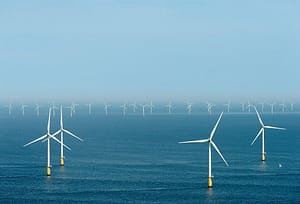While Cameron swings at windmills, companies are looking forwards, to cut costs and protect their future
Manufacturing is making a welcome comeback to the UK after having had a long holiday in China. This month, growth in the sector hit a five month high and firms are adding jobs at a rate of about 10,000 a month. The only problem set to spoil the party is the rising price of energy in Britain.
Energy prices have risen by 37% in the last three years, an unsustainable rise, and one which presents a “clear and present danger” of job losses, in the words of former energy minister Michael Fallon.
There has already been government action on the issue, which resulted in stripping out the green levies in tax bills. But this short term measure will do little to reassure companies that their bills aren’t going to continue climbing.
The problem businesses face – and the answer they’re creating
The UK is now a net importer of both gas and oil and British industry is at the mercy of the energy market.
There is a mix of factors at play here: the Big Six energy firms remain in control of 95% of the market; North Sea oil reserves are dwindling; our relationship with Russia has turned decidedly frosty; and the notion of a shale gas revolution remains toxic, with less than 49% of the population backing fracking, according to recent reports.
Meanwhile, progress on domestic nuclear power projects is painfully slow. Hinkley Point C, in Somerset, is the UK’s only new nuclear reactor under construction. It won’t be operational until 2023.
Firms know that energy prices are not going to miraculously fall in the future, and as a result, many have begun to find their own solutions to energy concerns.
As prices rocket, it makes commercial sense for companies to begin looking at generating their own power.
Companies in the US are leading the way. Ikea’s American arm recently announced the purchase of a 49-turbine wind farm in Illinois. When completed in 2020, the farm will produce an impressive 165% of the company’s electricity needs (in the US), which includes 38 stores, five distribution centres, two service centres and a factory. These 49 turbines will thereby contribute 18% of the global company’s energy usage.
Leading US tech firms including Microsoft, Facebook and Apple are also revolutionising corporate attitudes to renewable energy, with vast investments in solar and wind power. Microsoft is aiming to become a carbon-neutral company, and announced last year it would power one of its large data centres with electricity from a Texas wind farm, agreeing to buy the farm’s entire output for 20 years. Meanwhile, Apple powers 100% of its data centres with renewable energy, and 94% of its corporate campuses.
Meanwhile, back in Britain…
In the UK, we’re somewhat behind the curve. But things are beginning to change.
Running shoe manufacturer New Balance, which manufactures all its shoes at its factory in Cumbria, generates about 8% of its power through photovoltaic solar panels on the factory roof. It is aiming to double that percentage this year.
New Balance factory manager Andy Okolowitz says: “The increasing energy price was the thing that made me first look at installing the panels, no doubt about it.
“Our electricity prices have doubled in recent years, and at the end of the day you can’t carry on that way, so this is a good long term investment.”
In March 2013, London-based company Solar Century installed over 20,000 photovoltaic solar panels on the sloping roofs of car manufacturer Bentley’s Crewe factory. The installation made it the UK’s largest rooftop solar array, covering 3.45 hectares of roof space.
Bentley spokesman Matthew Reed says: “We take the sustainability of our products and factory extremely seriously and we are always looking for ways to reduce emissions and improve energy efficiency. That’s why we installed them. The panels reduce our energy costs and help ensure that our manufacturing operations in Crewe are efficient, sustainable and globally competitive.”
Bentley’s panels generate 5MW of power, enough to cover about 40% of Bentley’s factory energy requirements and reducing CO2 usage by an estimated 2,500 tonnes per year.
That is roughly the equivalent power needed to supply over 1,200 households.
Elsewhere, Ecotricity, the green energy supplier, has provided wind turbines to companies in the UK including B&Q, Ford and Michelin. At B&Q’s main distribution centre in Worksop, a single turbine generates more than 100% of the required electricity for the site, with enough left to supply local homes.
Ecotricity spokesman Stuart Brennan says: “You can certainly get cheaper electricity if you have on-site generation. [Firms] have realised that they needed to cut their overheads, and energy is one of the things that has really gone up over the last few years. If companies can cut their bills and cut down their carbon emissions, it can only be a good thing.”
Public perceptions
Public awareness of firms’ environmental record is also becoming an increasingly important factor for businesses. Companies are under more pressure to match their competitors’ standards, and a growing understanding of environmental and ethical issues is causing consumers to adjust their habits.
James Carpenter, director of renewable energy company Westinghouse Solar, says that consumers are adapting to this change in attitude faster than businesses.
He says: “The public are becoming more aware and are patronising and using companies that are sustainable. People are increasingly keen on recycling, sourcing things locally, and a lot of companies know how important that is. This will be one of the next things – where your power comes from and how you generate it and operate your business.”
Cost savings
There is vast scope for British businesses to reduce their energy costs through producing a portion of their own energy. Carpenter estimates that a small business in the UK may save £3,500 a year, while a medium-sized one can save £7,000 a year by installing solar panels.
“That’s just year one,” he says. “With bills going up above inflation, the savings are going to grow exponentially over a 20-year period.”
He adds: “With solar power we can really accurately forecast, over the next 20 years, how much power those panels are going to produce, to within 4-5% accuracy. So you’re hedging your future energy costs in a way. You know exactly what that base price is going to be. If you’re reliant on the open market then you don’t know what they’re going to be.”

Barriers & benefits
But there remain a number of barriers to greater adoption.
Initial outlay is still an issue, despite the price of solar panel installation having fallen by 50% over the last two years alone. But as more homes and businesses utilise the technology, the price will continue to fall due to economies of scale.
Initial costs vary widely depending on the size of the system and the type of solar panels used – some can be mounted onto existing roofs, while more sophisticated phot
ovoltaic roofing tiles can be used in place of ordinary roof materials.
After an initial outlay for panels, there are three ways to benefit from them financially. Firstly, in the UK you stand to gain through feed-in-tariffs – payment from the government for every unit of energy produced, whether you use that energy or not. This mechanism is not popular with the current government however, and the tariff is steadily being curtailed.
Secondly, you can make money through export tariffs. This is done by selling the power you’re not using while the sun is shining back to the grid. The rate of pay has declined from a high of 14p per kilowatt hour to roughly 4p, though you can lock down a rate for 20 years and it will rise with inflation.
Finally, the most obvious financial benefit is through energy savings. The amount solar panels generate depends on where they are placed, and ideally they require a 45-degree roof, facing south.
Political stalling
Political will remains something of a hurdle to mass uptake of renewable energy technology. Though there is a roadmap to increasing renewable power sources in the UK, efforts to introduce serious new initiatives have progressed slowly. Meanwhile, the coalition government began tapering its support for feed-in tariffs to subsidise solar installations in 2011, and as mentioned earlier, cut green levies from energy bills – or “the green crap”, as David Cameron is alleged to have described it.
Besides solar, the government has also become increasingly resistant to wind projects. Support for onshore wind projects is to be dramatically reduced, and efforts to make it economically difficult for such projects are likely to be introduced.
Instead, the government remains committed to experimental shale gas extraction, and is passing new laws to ensure opponents have no power to prevent headway with the work.
To date, only one shale gas drilling site has operated in the UK, but drilling was halted in 2011 after it caused earthquakes. Experimental drilling in Lancashire could begin next year, but it will be much longer before shale gas is powering any significant number of British businesses.
What’s next?
The move to renewable energy generation is gathering steam. In Australia, where similar concerns over energy prices exist, rapid take-up of domestic rooftop solar arrays has forced huge slashes in the wholesale price of energy, and stirred scepticism over the value of the grid.
According to the Commonwealth Scientific and Industrial Research Organisation, by 2040 over half of all electricity in Australia may be generated in the same place it’s used.
In England it is indisputably cloudier than Australia, but as solar technology continues to improve and costs continue to fall, it is unclear how centralised fossil-fuel generation can adapt to compete with cheaper, greener energy solutions.
British companies are tuning in to changing consumer expectations around ethical trading and environmental concerns. So as the price of power rises, it makes commercial sense to look for renewable energy solutions.






Leave a Comment